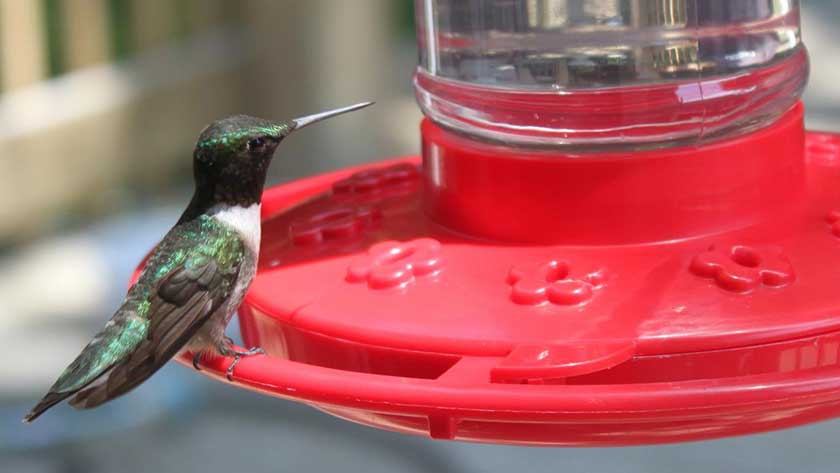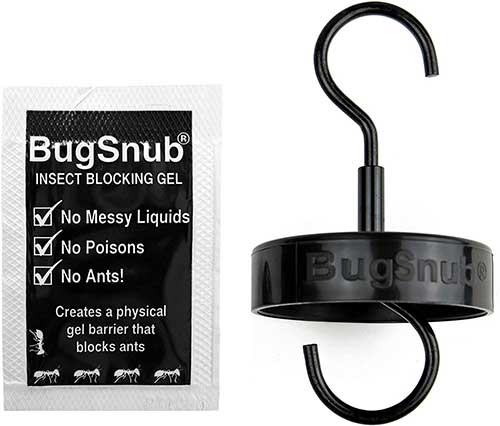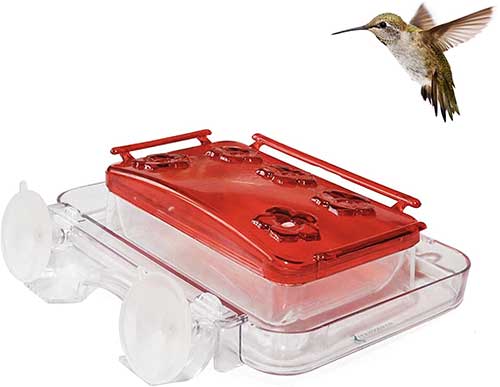It’s a familiar scenario. You put up a hummingbird feeder and in the first few weeks, there is a flurry of colorful visitors. But, then the hummingbirds suddenly stop making appearances. As you investigate, you still see nectar in the feeder.
But, there is also one other thing you didn’t expect: ants (and likely lots of them). Ants love that sweet stuff just as much as hummingbirds, so what can you do?

In this article, we will show you exactly how to keep ants off a hummingbird feeder for good! We will cover some of the most popular methods and recommend a few products. We will also throw in a few tips from people who have found creative solutions to this common problem.
Why Do Hummingbirds Avoid Ant-Infested Feeders?
Before we dive into the ants on the hummingbird feeder problem, we should probably answer why hummingbirds are so reluctant to share a hummingbird feeder with ants. It largely comes down to one simple fact: ants are extremely territorial — especially when a food source is involved. While hummingbirds are much larger, successive bites from a swarm of ants can be enough to deter even the most nectar-loving hummingbirds.
Hummingbirds are very social creatures. Proportionally, hummingbirds have a large ratio of brain mass to body mass than humans. You could almost compare their chirps and vocalizations to our Yelp and Twitter reviews. Hummingbirds are able to warn other hummingbirds about potential dangers. So, when a hummingbird encounters a feeder overrun with ants they are quick to alert their charm (the name for a group of hummingbirds). Quickly, your well-intentioned hummingbird feeder becomes a no-go zone for these beautiful birds. Let’s get down to the best ant prevention methods for hummingbird feeders, shall we?
Here Are the Most Effective Ways to Keep Ants Away from a Hummingbird Feeder
1. Check for Leaks
A leaking hummingbird feeder is an open invitation to ants, bees, and other sugar-loving critters. While a drip pan below the hummingbird feeder can be effective, one other alternative is to buy a dripless-style hummingbird feeder.
2. Ant Moat Hummingbird Feeder Hook

BugSnub has created an upside-down moat that uses a food-grade gel to prevent ants from accessing the feeder. Since the gel goes on the underside of this “moat-less moat” you don’t have to worry about rainwater affecting its ant-deterring properties. And, the gel won’t dry, collect leaves, or spill. The gel is good for one year. All you have to do is apply it each springtime and that’s it!
If you are currently having an issue with ants, one of the most effective (and cost-effective) methods is to “go medieval” and add an add moat to your feeder line. Since most ants reach a hummingbird feeder from the suspension line or hook, a baited ant moat is very effective at preventing the critters from reaching the feeder. BugSnub has taken ant moat design to the next level.
3. Dripless Ant Proof Hummingbird Feeder

You should also search for dripless feeders that require tongue pressure from a hummingbird. Since these models are pressure-based, they are usually effective in keeping ants away. One of the most popular dripless hummingbird feeders on the market these days is the Cuboid Insect-Proof Hummingbird Feeder. The Cuboid accommodates five hummingbirds at a time and has a built-in bee guard and ant moat. Plus, this model can either be suspended or attached to a window with the included suction cups.
4. Switch Up the Placement of the Feeder
Once ants find a fantastic food source (such as your hummingbird feeder), they leave behind a scent trail to make it easy for the rest of the colony to locate. While moving the location will work for a time, it can also throw off the hummingbirds who have grown used to feeding at a particular location. Before you move the hummingbird feeder to another location, you should also adjust your setup to prevent a recurrence of the ant problem. This could include adding an “ant moat” or using a slippery fishing line to suspend the feeder.
The best place to position a hummingbird feeder is in an area with partial shade. If it’s too dark, the hummingbirds may have trouble locating it. If it’s in an area that receives too much sunlight, the nectar could heat up too much, making it less favorable to hummingbirds.
5. The Fishing Line Method
Many hummingbird aficionados use fishing line to suspend their feeders. The logic is that the fishing line is too thin and slick for ants to traverse vertically. One great option is the Sufix Magic Fishing Line (Clear). This all-weather fishing line is thin enough to keep the ants away but strong enough to support four pounds of continuous weight. This line should be strong enough to support most hummingbird feeders that use less than a half-gallon of liquid, which is a vast majority of feeder models.
6. Mint and Bay Leaves
This is a method we haven’t tried ourselves, but several sources have told us that it is a fairly effective all-natural remedy. Ants apparently hate mint and bay leaves. Some hummingbird feeder owners tie either bay or mint leaves around the suspension cord leading to the hummingbird feeder. So, if you are looking for a more natural approach to deterring ants around your hummingbird feeder, this may be an effective way to do just that. Let us know if you’ve had successful results with this method and we’ll share your story on the Pest Control Gurus website!
Related Article: Pet Safe Ant Killers
7. Keeping the Bees Away

One popular hummingbird feeder that doesn’t have yellow is wine glass top purple Hummingbird Feeder. Since the reservoir is made of glass, you may want to go with a higher strength fishing line if you’re using that ant-control method, but also the red color will help to attract hummingbirds to your property. Red dye #40 (a common food coloring in hummingbird nectar) may also be carcinogenic. So, you may also look at other dye-free alternatives, such as boiling sugar in with water.
While this article is mostly focused on keeping ants away from your hummingbird feeder, it is worth mentioning that bees can also be a nuisance. If you’ve had a problem with bees around your hummingbird feeder, you may have been told to switch to a feeder that doesn’t have yellow-colored faux pedals. And, this is absolutely true. Bees are attracted to yellow. Instead, look for a hummingbird feeder that is all red. Hummingbirds can see the color red, but bees cannot.
Related Article: 8 Best Ant Killers
Questionable and Experimental Methods
Now that we’ve gone through some of the most popular and hummingbird-safe methods of ant control, we’d like to point out some other methods that you should probably avoid.
What About Adding Oils?
There are many websites and blogs out there that recommend adding oil to the outside of the hummingbird feeder to deter ants. We’ve talked to a number of experts on the matter and they universally conclude that adding oil is a bad idea. Even natural oils are unsafe. Here’s why. When a hummingbird comes into contact with an oiled feeder, they will spread that oil over their wings while preening. This added weight and oil cause the down to clump together. If this repeats over the span of several days, a hummingbird’s ability to fly is diminished and they may ultimately fall victim to common predators such as cats, hawks, eagles, and other animals. Therefore, it’s best to skip oils — even “essential oils” — and try an approach that doesn’t endanger the welfare of hummingbirds.
What About Adhesive Tape?
On some blogs, you might see a mention of wrapping adhesive tape around the pole of your hummingbird feeder. While this seems like a plausible life hack, ants have an exoskeleton made of chitin, a substance made of cellulose polymers. Since chitin is slick and oily, regular adhesive tape has little effect on ants. The smell might deter them, but after a few sunny days, the adhesive and scent properties of tape usually wear off. Some experts also warn about using adhesive tape and Tree Tanglefoot insect barriers as these can also cause health issues for birds.
Conclusion About Ants and Bird Feeders
Ah, you’ve made it! You are now better equipped to tackle that ant issue that has been plaguing your hummingbird feeder. In closing, we hope this article proves that there are plenty of natural ways to prevent ants from getting into hummingbird feeders.
If you’ve had a previous ant infestation, you should also wash out your hummingbird feeder so the ant carcasses or scents do not deter hummingbirds from returning.
Thanks for reading this article from Pest Control Gurus. We hope the tips presented in this short guide will lead to a season filled with hummingbird sightings and no ants! If you have any recommendations, suggestions, or thoughts that are not covered in this article, please let us know! We are always on the lookout for safe, eco-friendly methods to control pests and our readers’ contributions are helpful in creating a better-informed pest control community.
Related Article: 12 Best Squirrel Proof Bird Feeders
My name is Blane and I’m a life-long resident of Southeastern Louisiana. I’ve been working as Pest Control Technician and Inspector for about 1.5 years now.
I’ve worked in many other industries as well, including consulting, managing, as well as at the ground level in fields including Food Service, Corporate Automotive sales, and finance. Whether it be providing counsel, content, or hands-on support; my goal remains to add value to the lives of the people I serve.
If you have any questions regarding pest control, leave them below. I would be happy to help you out in any way I can.
